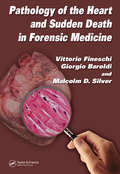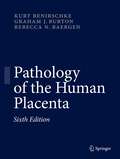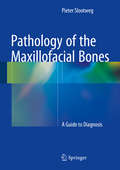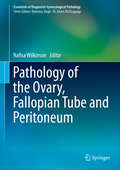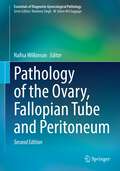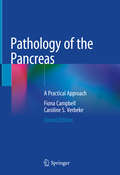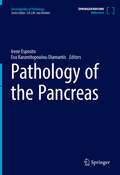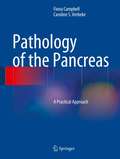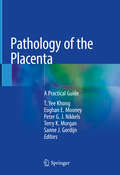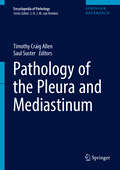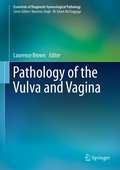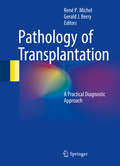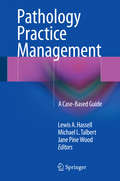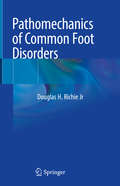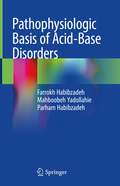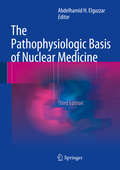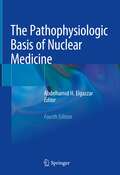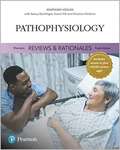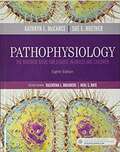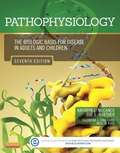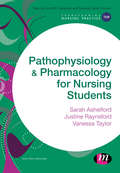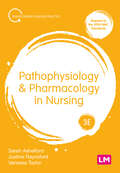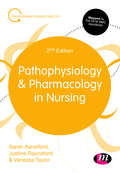- Table View
- List View
Pathology of the Heart and Sudden Death in Forensic Medicine
by Vittorio Fineschi Giorgio Baroldi Malcolm D. SilverAddressing the pathology of the heart and cardiovascular system from a forensic perspective, Pathology of the Heart and Sudden Death in Forensic Investigations guides the pathologist toward the effective resolution of cases. It critically reviews pertinent facts by revisiting pathologic findings and comparing them to etiopathogenic hypotheses, prop
Pathology of the Human Placenta
by Graham J. Burton Kurt Benirschke Rebecca N BaergenPathology of the Human Placenta remains the most comprehensive and authoritative text in the field. It provides extensive information on the normal placenta, encompassing physiology, metabolism, and endocrinology, and covers the full range of placental diseases in great detail. Further chapters are devoted to abortions, molar pregnancies, multiple pregnancies, and legal considerations. This sixth edition of the book has been extensively revised and expanded to reflect the most recent progress in the field, and a brand new chapter has been added on artificial reproductive technology. Some 800 illustrations are included, many of them in color. The detailed index has been further improved and tables updated. Pathology of the Human Placenta will be of enormous value to pathologists and obstetrician-gynecologists alike.
Pathology of the Maxillofacial Bones
by Pieter SlootwegThis book is divided into 3 main sections: cysts and odontogenic tumors (lesions related to the dentition); fibro-osseous lesions and giant cell lesions, which are unique to the maxillofacial skeleton; and bone lesions, which also occur in other parts of the body. Individual diseases are described with a special emphasis on histomorphological aspects. Some lesions may pose considerable diagnostic problems due to shared microscopical features and the authors' aim is to provide reliable diagnostic guidelines for the surgical pathologist who has to deal with specimens from this area. The majority of the currently available textbooks on head and neck pathology are mainly devoted to soft tissue lesions, paying less attention to the pathology of the diseases that involve the hard tissues. Texts on general skeletal pathology cannot address this gap, as the maxillofacial skeleton differs from the bones elsewhere in the body in several respects. Therefore, the book discusses both bone disorders that are restricted to the head and neck, and diseases that also occur in the extragnathic skeleton.
Pathology of the Mediastinum
by Alberto M. Marchevsky Mark R. WickAn updated edition which aims to reflect recent changes in the pathology, biology, surgery and other aspects of the thymus gland and mediastinal organs relevant to pathologists. This book covers selected cases from over 1000 mediastinal lesions from the authors' files.
Pathology of the Ovary, Fallopian Tube and Peritoneum
by Nafisa WilkinsonAs the second volume in the Essentials of Diagnostic Gynecological Pathology series sponsored by the British Association of Gynecological Pathologists, Pathology of the Ovary, Fallopian Tube and Peritoneum is one of the very few dealing wholly with this subject. Pathology of the Ovary, Fallopian Tube and Peritoneum introduces the topic with a discussion of the anatomy, development, histology and normal function of the ovary, followed by chapters on non-neoplastic disorders of the ovary; surgery and medical management of ovarian cancer; and the use of imaging, frozen sections and cytology in ovarian pathology. The book then goes on to describe specific disorders of the ovary, fallopian tube and peritoneum in detail, and finishes with a chapter on specimen cut-up. Pathology of the Ovary, Fallopian Tube and Peritoneum has been written to be useful diagnostically to general as well as specialist gynecological histopathologists and pathologists in training Gynecologists, oncologists, genitourinary physicians and cancer nurse specialists will find expert insights here that will help in treatment and counselling of their patients.
Pathology of the Ovary, Fallopian Tube and Peritoneum (Essentials of Diagnostic Gynecological Pathology)
by Nafisa WilkinsonThis heavily revised second edition in the Essentials of Diagnostic Gynecological Pathology series covers the anatomy, development, histology and normal function of the ovary. Detailed descriptions of non-neoplastic disorders of the ovary; surgery and medical management of ovarian cancer; and the use of imaging, frozen sections and cytology in ovarian pathology is discussed. The work also describes specific disorders of the ovary, fallopian tube and peritoneum. New chapters cover the latest technologies in relevant imaging techniques along with the application of molecular techniques in diagnostic and management practices. Pathology of the Ovary, Fallopian Tube and Peritoneum has been written to be useful diagnostically to general as well as specialist gynecological histopathologists and pathologists in training. Gynecologists, oncologists, genitourinary physicians and cancer nurse specialists will find expert insights here that will help in treatment and counselling of their patients.
Pathology of the Pancreas: A Practical Approach
by Fiona Campbell Caroline S. VerbekeThis updated volume provides a practical guide to pancreatic pathology that covers recent changes in concepts and classifications. Potential pitfalls and mimics in pancreatic pathology are highlighted and illustrated, and guidance is provided regarding how to recognise and avoid them. There is a new chapter on transplant pathology, and more than 200 new macroscopic and microscopic images have been added. Pathology of the Pancreas: A Practical Approach aims to enable readers to recognise the various pathological entities and provide the key information in their pathology reports, which is necessary for the individual patient’s further management. The book provides the diagnostic pathologist with a comprehensive, well-illustrated, and extensively cross-referenced approach to pancreatic pathology.
Pathology of the Pancreas (Encyclopedia of Pathology)
by Irene Esposito Eva Karamitopoulou-DiamantisThis encyclopedia volume covers the complete field of pathology of the pancreas – from Acinar cell neoplasms to Vascular resections. The alphabetically arranged entries, each of which provides a detailed description of a specific pathological disease pattern, allow readers to quickly and easily find the information they need.
Pathology of the Pancreas
by Caroline S. Verbeke Fiona CampbellPathology of the Pancreas: A Practical Approach covers all the diagnostic entities in adult pancreatic pathology, providing extensive illustrations and tables to assist the pathologist at the time of diagnostic reporting of histological and cytological specimens. Potential pitfalls and mimics in pancreatic pathology are highlighted and illustrated, and guidance is provided regarding how to recognize and avoid them. Pathology of the Pancreas: A Practical Approach enables the pathologist to recognize the various pathological entities and provide the key information in their pathology reports, which is necessary for the individual patient's further management. It is based on the most recent diagnostic algorithms, international consensus guidelines, and systems for disease classification, staging and grading. Clinical information is also included, where it is important for the multidisciplinary team management discussion. Pathology of the Pancreas: A Practical Approach is a bench book for everyday use beside the microscope and provides the diagnostic pathologist with a comprehensive, well-illustrated and extensively cross-referenced approach to pancreatic pathology.
Pathology of the Placenta: A Practical Guide
by T. Yee Khong Eoghan E. Mooney Peter G. J. Nikkels Terry K. Morgan Sanne J. GordijnPathology of the Placenta
Pathology of the Pleura and Mediastinum (Encyclopedia of Pathology)
by Timothy Craig Allen Saul SusterThis book covers the complete field of pleura and mediastinum pathology - from acquired multilocular thymic cyst to well-differentiated papillary mesothelioma. The alphabetically arranged entries, each of which provides a detailed description of a specific pathological disease pattern, allow readers to quickly and easily find the information they need.
Pathology of the Vulva and Vagina
by Laurence BrownDoctors and the general public are increasingly recognising diseases of the vulva and vagina as a cause of sexual dysfunction, morbidity and death, yet the wide but sometimes rare range of conditions involving this area are poorly represented in most textbooks of pathology. As the first volume in the Essentials of Diagnostic Gynecological Pathology series sponsored by the British Association of Gynecological Pathologists, Pathology of the Vulva and Vagina is one of the very few dealing wholly with this subject. Pathology of the Vulva and Vagina introduces the topic with a stylishly illustrated description of the embryology and development which is fundamental to understanding the pathogenesis and symptomatology. Subsequent chapters cover infections and non-infectious dermatoses, specifying those that can predispose to cancer. The precancerous conditions of vulval intraepithelial neoplasia, melanocytic proliferations and extra-mammary Paget's disease are integrated respectively with accounts of human papilloma virus, malignant melanoma and recent awareness of ano-genital mammary-like glands. Advances in the recognition of potentially confusing benign conditions, prognosis and staging update the pathology of squamous and adenocarcinoma in these organs. The difficulties of sentinel node biopsy are explored and a comprehensive chapter clearly highlights the difficult differential diagnosis of mesenchymal lesions. As most histopathology departments receive many gynecological specimens, Pathology of the Vulva and Vagina has been written to be useful diagnostically to general as well as specialist gynecological histopathologists and pathologists in training. Gynecologists, oncologists, dermatologists, genitourinary physicians and cancer nurse specialists will find expert insights here that will help in treatment and counselling of their patients.
Pathology of Transplantation
by René P. Michel Gerald J. BerryMany pathologists find the interpretation of biopsies and other surgical specimens from solid organ, stem cell and bone marrow transplants challenging. Pathology of Transplantation provides a practical structured and logical approach to the diagnostic interpretation of the range of specimens from patients with solid organ, stem cell and bone marrow transplants, including the assessment of native and donor organs, with emphasis on resolution of pathological and clinico-pathological differential diagnoses including the diverse forms of rejection, recurrent and de novo diseases, drug-induced alterations, infections and other pathologies relevant to the system or tissue. In addition, this provides information on some of the critical clinical consequences of pathological diagnoses and guidelines for interaction and effective communication with transplant clinicians thereby ensuring the best possible care to patients with transplants. Pathology of Transplantation provides a relatively simple but diagnostically comprehensive and practical book that the pathologist will keep on hand and pick up to rapidly find answers in daily practice of transplantation pathology.
Pathology Practice Management
by Lewis A. Hassell Michael L. Talbert Jane Pine WoodThe authors discuss useful tools and tricks of the trade in pathology practice management. In-depth chapters on coding and billing by nationally known consultant Dennis Padget will prepare you to evaluate coding and billing practices. Noted law experts Jane Pine Wood and Amelia Larsen, attorneys at McDonald Hopkins, highlight key issues in employment, insurance, and hospital contracts and provide examples of how to deal with tricky issues. Sections on human resources and group dynamics take on the vexing issues that people bring to work. Finally, the authors identify current trends and reason how these might play out. In providing a broad overview of pathology practice management, each chapter employs a didactic framework, including one or more scenarios to illustrate challenges encountered by the writers. This case-based approach facilitates interactive learning and will thus be particularly useful to pathology training programs. Whatever your stage in the field--from resident to senior pathologist, including those in leadership roles--Pathology Practice Management: A Case-Based Guide is essential reading.
Pathomechanics of Common Foot Disorders
by Douglas H. Richie JrThis new book consolidates the current knowledge of lower extremity biomechanics and pathomechanics and makes this information relevant to the study of common foot and ankle pathologies. The content is presented in a language and format that allows the clinician to review current evidence explaining the etiology of these disorders in order to formulate effective treatment interventions. In order to understand pathomechanics, the clinician must also become versed in the normal, healthy biomechanics of the lower extremity. A review of gait, muscle function and forces acting on the lower extremities during physical activity will be the focus of the first part of this book. The second part of the book will study the common, challenging pathologies treated on a daily basis by foot and ankle clinicians: hallux abducto valgus, hallux rigidus, metatarsalgia, digital deformities, adult acquired flatfoot, and plantar heel pain. These chapters discuss all the relevant factors contributing to these conditions, evaluating and exposing myths and misconceptions about the pathomechanics and treatments of these conditions. For each disorder, a comprehensive review of published research provides a foundation for an updated, valid description of etiology and risk factors. Providing a fresh approach to lower extremity pathomechanics and management strategies, Pathomechanics of Common Foot Disorders is a valuable resource for podiatrists and orthopedic foot and ankle surgeons at all levels.
Pathophysiologic Basis of Acid-Base Disorders
by Farrokh Habibzadeh Mahboobeh Yadollahie Parham HabibzadehThe book is a concise and informative text about acid-base disorders. The book begins with very simple mathematics, chemistry, and physiological concepts and smoothly connects these to various aspects of acid-base disturbances and blood gas disorders through many simple-to-understand case-based examples. It covers various important topics such as respiratory acidosis and alkalosis, metabolic acidosis and alkalosis, mixed disorders, arterial blood gas, etc. All chapters end with a simple take-home summary facilitating better understanding and recall value. This book showcases practical text important at all levels of medical education, right from a basic science student to an attending physician/surgeon. Students, interns, residents, fellows, and attending physicians working in a broad range of clinical settings, particularly anesthesiology, surgery, and critical care can find this book helpful.
The Pathophysiologic Basis of Nuclear Medicine
by Abdelhamid H. ElgazzarThis book, now in its third edition, aims to promote a deeper understanding of the scientific and clinical basis of nuclear medicine and the new directions in medical imaging. The new edition has been revised and updated to reflect recent changes and to ensure that the contents are in line with likely future directions. The book starts by providing essential information on general pathophysiology, cell structure and cell biology as well as the mechanisms of radiopharmaceutical localization in different tissues and cells. The clinical applications of nuclear medicine are then presented in a series of chapters that cover every major organ system and relate the basic knowledge of anatomy, physiology and pathology to the clinical utilization of various scintigraphic modalities. The therapeutic applications of nuclear medicine are discussed in a separate chapter, and the final chapter is devoted to the biologic effects of ionizing radiations, including radiation from medical procedures.
The Pathophysiologic Basis of Nuclear Medicine
by Abdelhamid H. ElgazzarThis book, now in its fourth edition, aims to promote a deeper understanding of the scientific and clinical basis of nuclear medicine and the new directions in medical imaging. The new edition has been revised and updated significantly to reflect recent changes and to ensure that the contents are in line with likely future directions. In addition to that, chapters have been reorganized in order to simplify the contents and to increase the readability. The book starts by providing essential information on general pathophysiology, cell biology and biologic effects of ionizing radiation followed by the mechanisms of radiopharmaceutical localization in different tissues and cells. This is followed by a series of chapters that covers all relevant organ systems presenting the basic knowledge of anatomy, physiology, and pathology and relating them to the clinical utilization of various scintigraphic modalities. The final chapter is devoted to the basis of therapeutic applications of nuclear medicine. The book will prove invaluable to all with an interest in the pathophysiologic basis of Nuclear Medicine, including nuclear medicine professionals, radiologists, surgeons, pediatricians and internal medicine physicians.
Pathophysiology (Pearson Reviews Nursing and Rationales)
by Mary Ann HoganNCLEX-RN® exam preparation for nursing courses covering pathophysiology. <p><p> A premier resource for NCLEX-RN test prep – now with Pearson Test Prep* Pearson Reviews & Rationales: Pathophysiology has prepared thousands of students for success on the NCLEX-RN exam. Part of the best-selling Pearson Reviews & Rationales series, this volume addresses all aspects of the exam covering pathophysiology. It provides a comprehensive outline review, related NCLEX®-style questions, and test-taking strategies that instructors can weave into their courses. <p><p> Fully updated to reflect the 2016 NCLEX-RN Test Plan, the 4th edition is now available with Pearson Test Prep, an online practice resource with hundreds of NCLEX-style questions and detailed rationales. <p><p> *Pearson Test Prep is included with new print copies of this title, but is not included with any digital versions.
Pathophysiology: The Biologic Basis for Disease in Adults and Children
by Kathryn L. McCance Sue E. HuetherLearn the what, how, and why of pathophysiology! With easy-to-read, in-depthdescriptions of disease, disease etiology, and disease processes, Pathophysiology: The Biologic Basis for Disease in Adults and Children, 8th Edition helps you understand the most important and most complex pathophysiology concepts. <p><p>This updated text includes more than 1,300 full-color illustrations and photographs to make it easier to identify normal anatomy and physiology, as well as alterations of function. This edition includes a NEW chapter on obesity and nutritional disorders, along with expanded coverage of rare diseases and epigenetics. It’s the most comprehensive and authoritative pathophysiology text available!
Pathophysiology: The Biologic Basis for Disease in Adults and Children (Seventh Edition)
by Kathryn L. Mccance Sue E. HuetherWritten by well-known educators Kathryn McCance and Sue Huether, and joined by a team of expert contributors, this resource is the most comprehensive and authoritative pathophysiology text available! A fully updated glossary includes 1,000 terms, and makes lookup easier by grouping together similar topics and terms. Outstanding authors Kathryn McCance and Sue Huether have extensive backgrounds as researchers and instructors, and utilize expert contributors, consultants, and reviewers in developing this edition. Chapter summary reviews provide concise synopses of the main points of each chapter. Consistent presentation of diseases includes pathophysiology, clinical manifestations, and evaluation and treatment. Lifespan content includes ten separate pediatric chapters and special sections with aging and pediatrics content. Algorithms and flowcharts of diseases and disorders make it easy to follow the sequential progression of disease processes. Nutrition and Disease boxes explain the link between concepts of health promotion and disease. EXTENSIVELY Updated content reflects advances in pathophysiology including tumor biology invasion and metastases, the epidemiology of cancer, diabetes mellitus, insulin resistance, thyroid and adrenal gland disorders, female reproductive disorders including benign breast diseases and breast cancer, and a separate chapter on male reproductive disorders and cancer. NEW! Chapter on epigenetics and disease. Additional What's New boxes highlight the most current research and clinical development.
Pathophysiology and Pharmacology for Nursing Students (Transforming Nursing Practice)
by Sarah Ashelford Vanessa Taylor Justine RaynsfordCarefully designed to provide an integrated introduction to both the biology of disease and the therapeutic agents that are used to manage them, this book considers the underlying pathology of many common illnesses and diseases but by focusing on those conditions which have a pharmacological intervention is able to provide nurses with a broader understanding of bioscience that reflects care given in practice. It covers the basics of pharmacology, the core pathological concepts of inflammation, infection and cancer as well as a systems-based consideration of the pathophysiology and relevant pharmacology of common disorders. Providing the ideal starting point for student nurses to develop a robust, integrated knowledge of human disease and pharmacology, this book will enable them to provide care based on up-to-date knowledge of this important subject.
Pathophysiology and Pharmacology in Nursing (Transforming Nursing Practice Series)
by Sarah Ashelford Justine Raynsford Vanessa TaylorWritten in clear language and specifically for the nursing context, the new edition of this bestselling book is your ultimate guide to pathophysiology and pharmacology. Through a uniquely integrated approach, the book develops your knowledge of both the pathology of common conditions and their pharmacological treatment. This holistic approach builds your knowledge of the key concepts and processes, with real world examples illustrating their application to nursing practice. Key features Logical structure that starts with the basics and before developing your understanding of more complex areas Real world case studies demonstrate the application of pathophysiology and pharmacology across all fields of nursing A clear and concise writing style makes complex terminology and biological processes easy to understand Revised and updated in line with contemporary evidence and best practice Mapped to the 2018 NMC Standards
Pathophysiology and Pharmacology in Nursing (Transforming Nursing Practice Series)
by Sarah Ashelford Justine Raynsford Vanessa TaylorWritten in clear language and specifically for the nursing context, the new edition of this bestselling book is your ultimate guide to pathophysiology and pharmacology. Through a uniquely integrated approach, the book develops your knowledge of both the pathology of common conditions and their pharmacological treatment. This holistic approach builds your knowledge of the key concepts and processes, with real world examples illustrating their application to nursing practice. Key features Logical structure that starts with the basics and before developing your understanding of more complex areas Real world case studies demonstrate the application of pathophysiology and pharmacology across all fields of nursing A clear and concise writing style makes complex terminology and biological processes easy to understand Revised and updated in line with contemporary evidence and best practice Mapped to the 2018 NMC Standards
Pathophysiology and Pharmacology in Nursing (Transforming Nursing Practice Series)
by Sarah Ashelford Vanessa Taylor Justine RaynsfordPathophysiology and Pharmacology in Nursing has been carefully designed to provide an integrated introduction to both the biology of disease and the therapeutic agents that are used to manage them. It covers the basics of pharmacology, the core pathological concepts of inflammation, infection and cancer, as well as a systems based consideration of the pathophysiology and relevant pharmacology of common disorders. New to the second edition: All content updated and mapped to the 2018 NMC standards Two new chapters on ‘Mental health conditions’ and ‘Renal conditions. The ideal starting point for student nurses to develop a robust, integrated knowledge of human disease and pharmacology, enabling them to provide care that is based on up-to-date knowledge of this important subject.
